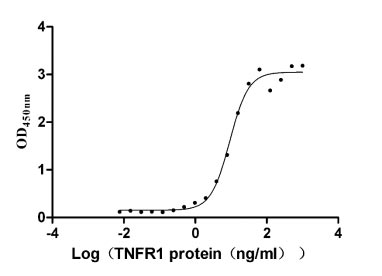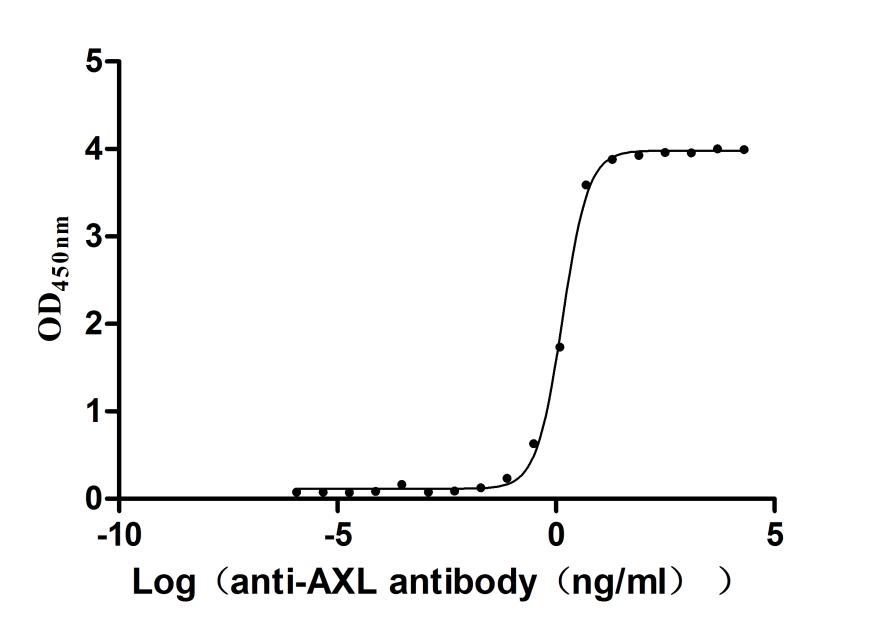Recombinant Human Caveolin-3 (CAV3)
-
中文名称:Recombinant Human Caveolin-3(CAV3),Yeast
-
货号:CSB-YP004573HU
-
规格:
-
来源:Yeast
-
其他:
-
中文名称:Recombinant Human Caveolin-3(CAV3),Yeast
-
货号:CSB-EP004573HU-B
-
规格:
-
来源:E.coli
-
共轭:Avi-tag Biotinylated
E. coli biotin ligase (BirA) is highly specific in covalently attaching biotin to the 15 amino acid AviTag peptide. This recombinant protein was biotinylated in vivo by AviTag-BirA technology, which method is BriA catalyzes amide linkage between the biotin and the specific lysine of the AviTag.
-
其他:
-
中文名称:Recombinant Human Caveolin-3(CAV3),Yeast
-
货号:CSB-BP004573HU
-
规格:
-
来源:Baculovirus
-
其他:
-
中文名称:Recombinant Human Caveolin-3(CAV3),Yeast
-
货号:CSB-MP004573HU
-
规格:
-
来源:Mammalian cell
-
其他:
产品详情
-
纯度:>85% (SDS-PAGE)
-
基因名:
-
Uniprot No.:
-
别名:CAV3; CAV3_HUMAN; Caveolin 3; Caveolin-3; LGMD1C; LQT9; M-caveolin; MGC126100; MGC126101; MGC126129; OTTHUMP00000115603; OTTHUMP00000207105; VIP 21; VIP21
-
种属:Homo sapiens (Human)
-
蛋白长度:Full length protein
-
表达区域:1-151
-
氨基酸序列MMAEEHTDLE AQIVKDIHCK EIDLVNRDPK NINEDIVKVD FEDVIAEPVG TYSFDGVWKV SYTTFTVSKY WCYRLLSTLL GVPLALLWGF LFACISFCHI WAVVPCIKSY LIEIQCISHI YSLCIRTFCN PLFAALGQVC SSIKVVLRKE V
-
蛋白标签:Tag type will be determined during the manufacturing process.
The tag type will be determined during production process. If you have specified tag type, please tell us and we will develop the specified tag preferentially. -
产品提供形式:Lyophilized powder
Note: We will preferentially ship the format that we have in stock, however, if you have any special requirement for the format, please remark your requirement when placing the order, we will prepare according to your demand. -
复溶:We recommend that this vial be briefly centrifuged prior to opening to bring the contents to the bottom. Please reconstitute protein in deionized sterile water to a concentration of 0.1-1.0 mg/mL.We recommend to add 5-50% of glycerol (final concentration) and aliquot for long-term storage at -20℃/-80℃. Our default final concentration of glycerol is 50%. Customers could use it as reference.
-
储存条件:Store at -20°C/-80°C upon receipt, aliquoting is necessary for mutiple use. Avoid repeated freeze-thaw cycles.
-
保质期:The shelf life is related to many factors, storage state, buffer ingredients, storage temperature and the stability of the protein itself.
Generally, the shelf life of liquid form is 6 months at -20°C/-80°C. The shelf life of lyophilized form is 12 months at -20°C/-80°C. -
货期:Delivery time may differ from different purchasing way or location, please kindly consult your local distributors for specific delivery time.Note: All of our proteins are default shipped with normal blue ice packs, if you request to ship with dry ice, please communicate with us in advance and extra fees will be charged.
-
注意事项:Repeated freezing and thawing is not recommended. Store working aliquots at 4°C for up to one week.
-
Datasheet :Please contact us to get it.
相关产品
靶点详情
-
功能:May act as a scaffolding protein within caveolar membranes. Interacts directly with G-protein alpha subunits and can functionally regulate their activity. May also regulate voltage-gated potassium channels. Plays a role in the sarcolemma repair mechanism of both skeletal muscle and cardiomyocytes that permits rapid resealing of membranes disrupted by mechanical stress. Mediates the recruitment of CAVIN2 and CAVIN3 proteins to the caveolae.
-
基因功能参考文献:
- T78M cav-3 induces complex modifications in ion channel function that ultimately alter membrane excitability and thus generate a susceptible substrate that, in concert with other structural alterations and/or genetic mutations, may become arrhythmogenic. PMID: 28898996
- Case series demonstrates that exercise intolerance, myalgia and rhabdomyolysis may be caused by CAV3 mutations and broadens phenotypic spectrum of caveolinopathies. Percussion-induced rapid muscle contractions were seen in 5 of 6 patients. A previously reported heterozygous mutation in CAV3 (p.T78M) and 3 novel variants (p.V14I, p.F41S, p.F54V) were identified. >50% reduction of caveolin-3 in 5 patients vs controls. PMID: 27312022
- our study indicates that TASK-1 is functionally regulated by caveolin-3, possibly via association with each other on the cell surface. These results point out a novel mechanism in the regulation of TASK-1. PMID: 28648645
- The caveolin 3 G56S variant is not a clearly pathogenic mutation, but may influence cellular functions and morphologies resulting in an increased cellular vulnerability in terms of a modifying factor. PMID: 27739254
- Our results indicate that HCN4 channel function is modulated by cav-3. LQTS-associated mutations of cav-3 differentially influence pacemaker current properties indicating a pathophysiological role in clinical manifestations. PMID: 28648120
- This study demonstrated that the Caveolin-3 is aberrantly expressed in skeletal muscle cells in myasthenia gravis. PMID: 27863830
- Study characterized the secondary structure, dynamics, and topology of a lipidated full-length human Cav3 construct, demonstrated that the N-terminal domain undergoes a dramatic topological rearrangement in both micelles and vesicles that is reversibly mediated by pH PMID: 27276265
- The Cav3 P104L mutation of limb girdle muscular dystrophy-1C leads to disordered glucose metabolism in muscle cells. PMID: 28232187
- Data (including data from studies using recombinant proteins that lack typical in-vivo post-translational modifications such as palmitoylation) suggest Cav3 exhibits little tendency to partition into liquid-ordered domains of unilamellar vesicles. PMID: 26859249
- MURC/cavin-4, especially in combination with Cav-3, may play a consistent role in the differentiation process of rhabdomyosarcoma. PMID: 26086601
- This study demonstrated that cav3 mutation in stinct disorders including limb-girdle muscular dystrophy 1C, rippling muscle disease, and isolated creatine kinase elevation in Greece. PMID: 26185955
- In a nonreferred nationwide Danish cohort of SIDS cases, up to 5/66 (7.5%) of SIDS cases can be explained by genetic variants in the sodium channel complex genes. PMID: 25757662
- We identified three novel sequence variations (c.183C>G, p.S61R; c.220C>A, p.R74S; c.220C>T, p.R74C) and found evidence that one was associated with hypercreatine kinase-emia PMID: 25630502
- our results indicate that inhibition of Cav3 currents by 5,6-epoxyeicosatrienoic acid is an important mechanism controlling the vascular tone. PMID: 24327205
- detrimental effect of Cav-3 V82I variant on cell viability may participate in determining the susceptibility to cardiac death. PMID: 24917393
- The caveolin-3:p.T78M did not exhibit a long-QT syndrome phenotype. PMID: 24021552
- Cav3 is an important negative regulator for cardiac late sodium cutrrent via nNOS dependent direct S-nitrosylation of SCN5A. PMID: 23541953
- data show a developmental change in HCN4-Cav3 association in human embryonic stem cell-derived cardiomyocytes. Cav3 expression and its association with ionic channels likely represent a crucial step of cardiac maturation PMID: 23311301
- A very high prevalence of previously SIDS-associated variants was identified in exome data from population studies. PMID: 23465283
- Kir2.1 loss of function is additive to the increase in late sodium current, prolonging repolarization and leading to arrhythmia generation in Cav3-mediated long qt syndrome 9. PMID: 23640888
- These results strongly suggest that cav3 possesses direct interaction with KCa1.1, presumably at the same domain for cav1 binding. PMID: 23237801
- Multiple caveolin-3 nonamers bind to a single RyR1 homotetramer. PMID: 23071107
- hERG expression in the plasma membrane is regulated by Cav3 via Nedd4-2 PMID: 22879586
- Stromal caveolin-3 expression were more frequent in anaplastic carcinoma and diffuse sclerosing variant of papillary carcinoma compared to conventional papillary thyroid carcinoma. PMID: 22236542
- Detailed analysis of the voltage-dependence of Ca2+ transients revealed a significant shift of Ca2+ release activation to higher depolarization levels in CAV3 mutated cells. PMID: 21294223
- Caveolin 3 expression was decreased in an animal model of left ventricular dysfunction and heart failure. PMID: 21362533
- Cav-3 is SUMOylated in a manner that is enhanced by the SUMO E3 ligase PIASy; Cav-3 SUMOylation in the mechanisms for beta(2)AR but not beta(1)AR desensitization PMID: 21362625
- -3 defects lead to four distinct skeletal muscle disease phenotypes: limb-girdle muscular dystrophy, rippling muscle disease, distal myopathy, and hyperCKemia[review] PMID: 21496630
- functional modulation of the Ca(v)3.2 channels by Cav-3 is important for understanding the compartmentalized regulation of Ca(2+) signaling during normal and pathological processes. PMID: 21084288
- Results describe differential effects of the R26Q and P28L caveolin-3 mutants on growth factor signaling. PMID: 20472890
- Impaired muscle contraction in gallbladders with cholesterol stones is due to high caveolar levels of cholesterol that inhibits CAV-3 generation; cholesterol increases the caveolar sequestration of CAV-3 and CCK-1R. PMID: 20558763
- Genetic analysis revealed a CAV3 c.G136A transition resulting in an A46T missense mutation in a family with rippling muscle disease. PMID: 20229577
- Caveolin-3 (Cav3) is a new Cx43-interacting protein. PMID: 19544087
- Review addresses caveolin-3 biological functions in muscle cells and describes the muscle and heart disease phenotypes associated with caveolin-3 mutations[REVIEW] PMID: 19584897
- A heterozygous 80 G-->A substitution in the caveolin-3 gene is associated with sporadic distal myopathy PMID: 11805270
- A naturally occurring caveolin-3 mutation can inhibit signaling involving cholesterol-sensitive raft domains. PMID: 11884389
- P28L mutation in the CAV-3 gene and the consequent caveolin-3 deficiency is associated with elevated serum kreatine kinase levels. PMID: 12082049
- Effects of deleting a tripeptide sequence observed in muscular dystrophy patients on the conformation of peptides corresponding to the scaffolding domain of caveolin-3. PMID: 12387816
- caveolin-3 may play a role in lamellar granule assembly, trafficking, and/or function. PMID: 12648214
- severe form of rippling muscle disease associated with homozygous CAV3 mutations. PMID: 12666119
- A haploinsufficiency model is proposed in which reduced levels of wild-type caveolin-3, although not rendered dysfunctional due to the caveolin-3 R26Q mutant protein, are insufficient for normal muscle cell function. PMID: 12839838
- Adenovirus-mediated overexpression of human caveolin-3 inhibits hypertrophic responses in rat cardiomyocytes. PMID: 12847114
- An R27Q missense mutation in the CAV3 gene can lead to various clinical phenotypes including hyper-CK-emia, rippling muscle disease, distal myopathy, and limb-girdle musclar dystrophy 1C. PMID: 12939441
- CD36 colocalizes with caveolin-3, suggesting that caveolae may regulate cellular fatty acid uptake by CD36. CD36 expression is higher in type 1 compared with type 2 fibers, whereas caveolin-3 expression is significantly higher in type 2 than in type 1 PMID: 14729862
- the importance of dysferlin-caveolin 3 relationship for skeletal muscle integrity PMID: 14749532
- Review. Caveolin-3 mutations can result in four distinct, sometimes overlapping, muscle disease phenotypes: limb girdle muscular dystrophy, rippling muscle disease, distal myopathy, and hyperCKemia. PMID: 14981167
- A muscle biopsy showed a partial reduction of caveolin-3 at the sarcolemma of muscle fibres.Mutational analysis identified a novel heterozygous mutation and generating a Val-->Met change at codon 57 of the amino acid chain. PMID: 15099591
- demonstrate that Cav-3 is specifically expressed in human cardiac and skeletal myocytes, with high specificity and relatively high sensitivity (88%) for tumors with skeletal muscle differentiation PMID: 16082247
- The s describe a family with autosomal dominant rippling muscle disease (RMD) and prominent early-onset toe walking. Molecular analysis revealed a novel heterozygous G > A transition at nucleotide position 136 in exon 2 of the caveolin-3 gene. PMID: 16247063
- The co-localization of Cav-3 with COX-2 in the caveolae suggests that the caveolins might play an important role for regulating the function of COX-2. PMID: 16479074
显示更多
收起更多
-
相关疾病:Limb-girdle muscular dystrophy 1C (LGMD1C); HyperCKmia (HYPCK); Rippling muscle disease 2 (RMD2); Cardiomyopathy, familial hypertrophic (CMH); Long QT syndrome 9 (LQT9); Sudden infant death syndrome (SIDS); Myopathy, distal, Tateyama type (MPDT)
-
亚细胞定位:Golgi apparatus membrane; Peripheral membrane protein. Cell membrane; Peripheral membrane protein. Membrane, caveola; Peripheral membrane protein. Cell membrane, sarcolemma.
-
蛋白家族:Caveolin family
-
组织特异性:Expressed predominantly in muscle.
-
数据库链接:
HGNC: 1529
OMIM: 123320
KEGG: hsa:859
STRING: 9606.ENSP00000341940
UniGene: Hs.98303
Most popular with customers
-
Recombinant Paguma larvata Angiotensin-converting enzyme 2 (ACE2), partial (Active)
Express system: Mammalian cell
Species: Paguma larvata (Masked palm civet)
-
Recombinant Human Tumor necrosis factor receptor superfamily member 1A (TNFRSF1A), partial (Active)
Express system: Mammalian cell
Species: Homo sapiens (Human)
-
Express system: Mammalian cell
Species: Macaca fascicularis (Crab-eating macaque) (Cynomolgus monkey)
-
Recombinant Macaca fascicularis Membrane spanning 4-domains A1 (MS4A1)-VLPs (Active)
Express system: Mammalian cell
Species: Macaca fascicularis (Crab-eating macaque) (Cynomolgus monkey)
-
Recombinant Human Interleukin-12 receptor subunit beta-1(IL12RB1),partial (Active)
Express system: Mammalian cell
Species: Homo sapiens (Human)
-
Recombinant Human Tyrosine-protein kinase receptor UFO(AXL),partial (Active)
Express system: Mammalian cell
Species: Homo sapiens (Human)


















